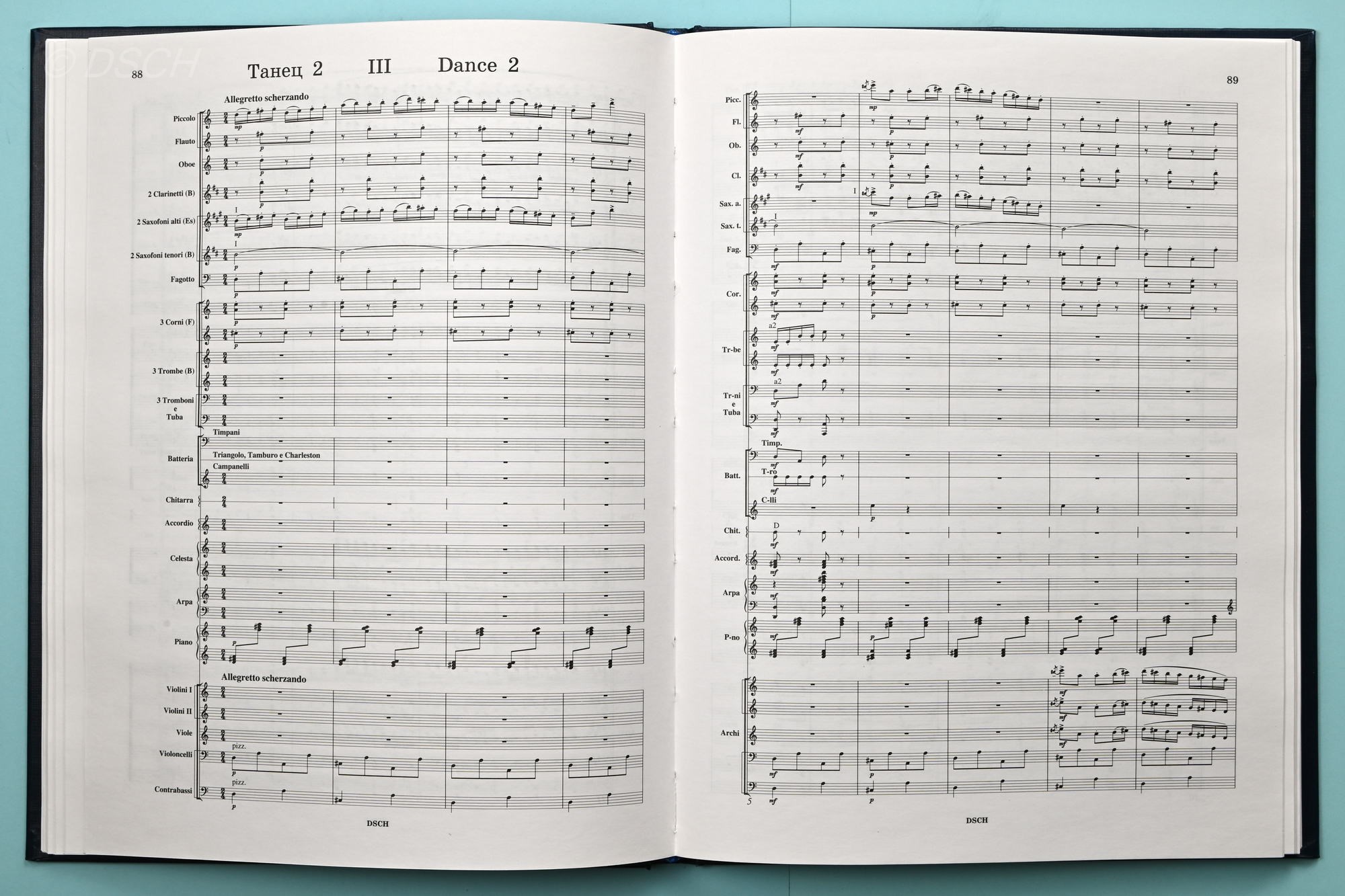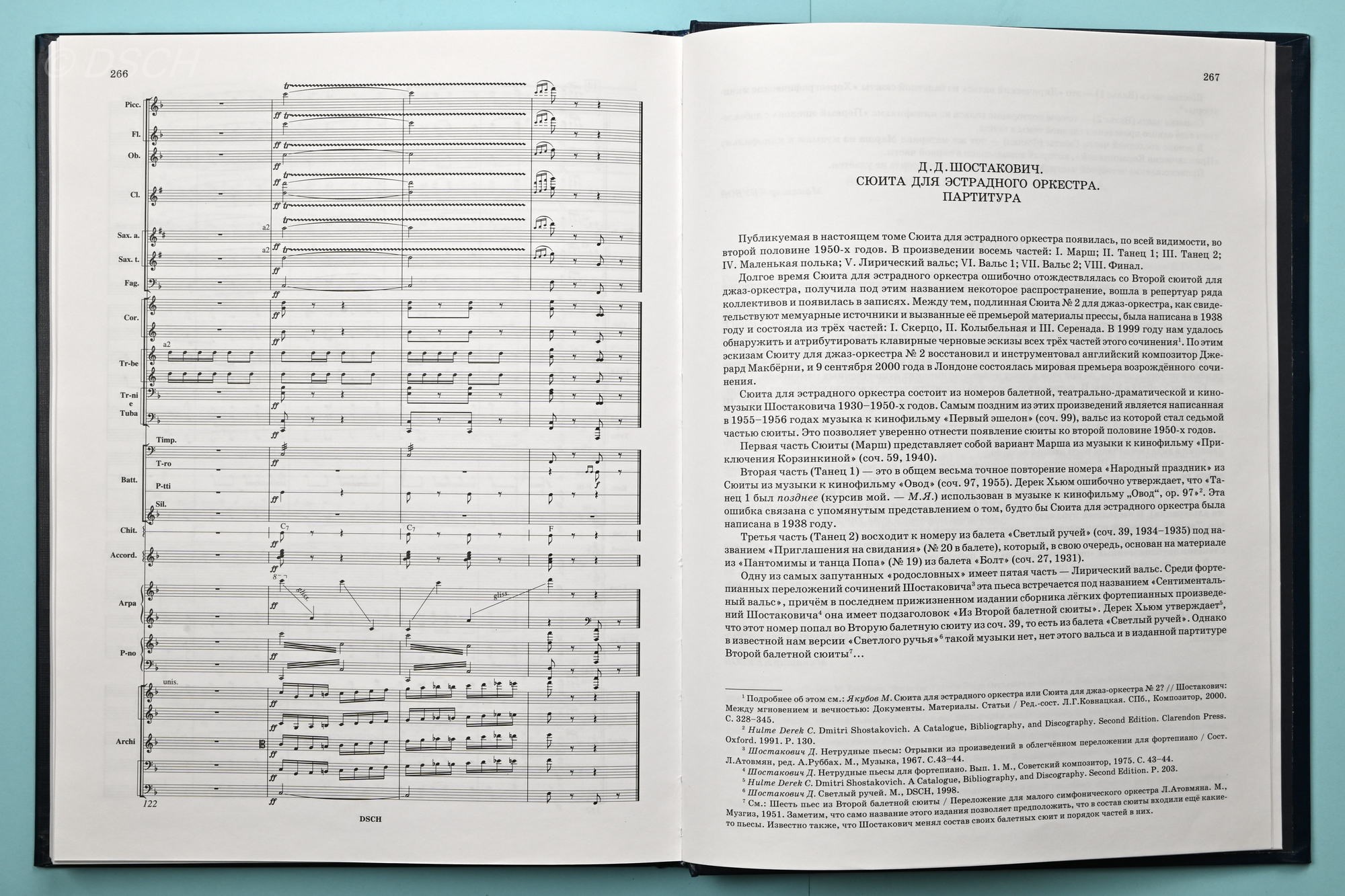Shostakovich, Dmitri - Suite for Jazz (Variety Stage) Orchestra - Full Score (New Collected Works vol.33)
Instrumentation: (full score) New Collected Works 33
Click below to view music sample pages


For a long time the Suite for Variety Stage Orchestra was erroneously identified with Suite for Jazz Orchestra No. 2, it gained some renown under the name of Suite for Jazz Orchestra No. 2, and became part of the repertoire of several orchestras and appeared in recordings under this name. However, the real Suite for Jazz Orchestra No. 2, as the memoir sources and press documents in the wake of its premier testify, was written in 1938 and consisted of three movements: I. Scherzo, II. Lullaby, and III. Serenade. In 1999, we succeeded in finding and attributing the piano drafts of all three movements of this composition. According to these drafts, Suite for Jazz Orchestra No. 2 was revived and instrumented by English composer Gerard McBurney, and on 9 September 2000, the world premiere of this new composition was held in London.
The Suite for Variety Stage Orchestra consists of ballet, incidental, and film music pieces written by Shostakovich during the 1930s-1950s. The latest of these compositions is the film music to The First Echelon (Op. 99) written in 1955-1956, the waltz from which became the seventh movement of the suite. This makes it possible to date the appearance of the suite to the second half of the 1950s.
The first movement of the Suite (March) is a version of the "March" from the film music to The Adventures of Korzinkina (Op. 59, 1940).
The second movement (Dance 1) is, in general, a precise reiteration of the "National Holiday" piece from the Suite from the film music to The Gadfly (Op. 97, 1955). Derek Hulme erroneously claims, Dance 1 used later in The Gadfly, Op. 97. This mistake is due to the notion mentioned above that the Suite for Variety Stage Orchestra was supposedly written in 1938.
The third movement (Dance 2) goes back to an item from the ballet The Limpid Stream (Op. 39, 1934-1935) entitled "Invitations to a Rendezvous" (No. 20 in the ballet), which, in turn, is based on "Pantomime and Dance of a Priest" (No. 19) from the ballet The Bolt (Op. 27, 1931).
The fifth movement, Lyric Waltz, has one of the most muddled “pedigrees”. This piece is found among the piano arrangements of Shostakovich's compositions under the title "Sentimental Waltz", whereby in the last lifetime edition of the collection of Shostakovich's light piano compositions, it was subtitled "From the Second Ballet Suite". Derek Hulme maintains that this piece was included in the Second Ballet Suite from Op. 39, that is, from the ballet The Limpid Stream. But in the version of The Limpid Stream we know, there is no such music, nor is there such a waltz in the published score of the Second Ballet Suite…
The sixth movement (Waltz 1) is the "Lyric Waltz" from the ballet suite Choreographic Miniatures.
The seventh movement (Waltz 2) is an exact duplication of the waltz from the film The First Echelon, with another development of the main theme added on at the end.
The eight movement of the suite (Finale) is based on the same "March" from the film music to The Adventures of Korzinkina, which was used in the first movement.
We have been unable to ascertain the origin of the fourth movement (Little Polka).
This score of the Suite for Variety Stage Orchestra in Eight Movements is based on the hand-written score kept in Dmitri Shostakovich's Archives. The Suite was orchestrated for a specific music collective of a rather unusual composition, in which, in particular, the violins were divided into three groups instead of the customary two: Violini I, Violini II, and Violini III, and two pianos. This peculiarity could create some practical difficulties, since it requires two pianos and an additional script for the Violini III part. The published version of the score is as close as possible to the traditional composition of a variety stage orchestra, but in so doing, no significant changes have been introduced into the text. The Violini I and Violini II groups, which frequently duplicate each other in unison in the hand-written score, are combined into one part, Violini I, and whenever necessary are played divisi. Correspondingly, the Violini III part becomes Violini II. Without significant changes to the music text, the parts of the two pianos can be played on one piano in four hands. Whenever necessary, this edited version was copied in our publication in the form of Ossia Piano: parti primo e secondo.
This ambitious series by DSCH, the exclusive publisher of the works of Dmitri Shostakovich, when complete, will run to 150 volumes.
Based on authentic manuscripts, accompanied by commentaries in Russian and in English, each volume contains new engravings, articles relating to the history of the compositions, facsimile pages of Shostakovich's manuscripts, outlines, and rough drafts.
Divided into 15 different "series" or genres, the edition will include nearly all the original works of the composer, and his instrumentation of music by Domenico Scarlatti, Beethoven, Schubert, Schumann, Mussorgsky, Rimsky-Korsakov, Johann Strauss, Youmans, Braga, Tishchenko, and others.
25% of the New Collected Works will be made up of previously unpublished material: over 80 of his works are being published here for the first time. Many of these previously unknown works could not be published or performed during the composer's lifetime for ideological reasons.
The fifteen "series" within the edition comprise:
I: Symphonies (vols 1-30)
II: Orchestra Compositions (vols 31-37)
III: Instrumental Concertos (vols 38-49)
IV: Compositions for the Stage (vols 50-67)
V: Suites from Operas and Ballets (vols 68-72)
VI: Compositions for Choir and Orchestra (With or Without Soloists) (vols 73-83)
VII: Unaccompanied Choral Compositions/Arrangements of Russian Folksongs (vols 84-86)
VIII: Compositions for Solo Voice(S) With Orchestra (vols 87-90)
IX: Chamber Compositions for Voice and Songs (vols 91-97)
X: Chamber Instrumental Ensembles (vols 98-105)
XI: Instrumental Sonatas(vols 106-108)
XII: Piano Compositions (vols 109-115)
XIII: Incidental Music (vols 116-121)
XIV: Film Music (vols 122-145)
XV: The Works of Other Composers, Instrumentation by Shostakovich (vols 146-150)

